Why the US and China will clash over the electricity grids of the future

The energy transition requires the modernization and expansion of electricity networks: this is what the US, EU, China and beyond will do. The analysis by Marco van Lent, Senior Portfolio Manager Equities at Robeco
The energy crisis that hit Europe and is spreading around the world in the face of a record drought in the northern hemisphere reminds us that the transition from fossil fuels to renewable energy is both environmentally and socially necessary. that of security. Less well known is that the crucial enabler of this transition will be the redesign and rebuilding of sophisticated power grids capable of accommodating increased electricity generation and distribution and dynamically managing demand.
The International Energy Agency (IEA) projects that global investment in electricity networks will need to reach $820 billion annually by 2030, up from around $260 billion in 2020, if the necessary renewable energy projects are to be activated to limit global warming to 1.5°C above pre-industrial levels.
The existing power grid is no longer fit for purpose
The current structure of the electricity networks is based on a generation capacity powered mainly by fossil fuels, located in carefully selected strategic locations and directed to consumers with a unidirectional flow. This system was manageable because fossil fuels such as coal were plentiful and cheap, and generating capacity could be brought on and off relatively quickly. However, the infrastructure is aging and often unable to efficiently accommodate and deploy new generation capacity, cope with extreme weather conditions, or meet new sources of demand such as vehicle electrification.
The grid of the future will likely include an energy source such as hydroelectric or nuclear, which is weather-independent in the short term and capable of providing baseload power. Added to this are renewable sources such as wind and solar on a much larger scale than currently installed. This will require new long-distance transmission lines, even to replace the old ones, which starting from potentially remote places such as offshore plants or desert areas will connect to special junctions where the current will be converted into low voltage for local distribution.
Other electricity will come from traditional consumption points, such as private homes and factories, via interconnectors that plug into the wider grid. The increased complexity and horizontal integration of the network will be managed by special hubs with direct data transfer from the points of consumption, or from the "grid edge". If the utility has more accurate information about end-user consumption and supplies, energy flows can be optimized in real time. Managing peak demand and reducing peak energy will provide immediate cost and reliability benefits and help justify the large investments needed to build new power lines.
The current situation
The development of the network continues gradually, with the entry into operation of renewable energy sources and the replacement of the current obsolete infrastructure. During this decade we expect greater strategic involvement at the federal level in the United States and at the community level in Europe to build smarter, more efficient and resilient grids. Below we have summarized the current state of affairs in the three largest economic blocs:
Europe
Energy policy in Europe is currently in turmoil due to the sudden cut in supplies of Russian gas and the consequent surge in prices at the margin. These developments triggered immediate panic and heightened the possibility of conflicts between Member States in the winter of 2022-2023, but in the medium to long term this crisis is likely to prove to be a catalyst for Europe-wide mainstreaming of the future development of network, expanding the capacity to transmit electricity between Member States.
China
China intends to significantly expand its electricity generation capacity by 2025, bringing it to 1.36 times the 2020 level, and knows that for this purpose it is necessary to have a more flexible grid. Concerns about energy security, the rapid addition of new renewable energy projects and the need to transfer energy from China's less populated western regions to the east coast are all factors driving grid investment.
United States
The US network, like the European one, has grown organically without planning at the federal level. Some recent laws, including the Infrastructure Investment and Jobs Act of November 2021 and the Inflation Reduction Act of August 2022, have provided allocations for investments in the network, which are however far from the level actually required, so the burden will fall on the private sector. In particular, there are no transmission line tax credits, and grid infrastructure bottlenecks, such as statewide planning permits, continue to be a problem.
Conclusions
The construction of the next generation network will take many years, perhaps decades. Some investment opportunities related to the redesign of the power grid will still have to wait, but many companies, including engineering and construction companies, electrical component manufacturers and utilities, are already building the new network brick by brick and cable by cable. These companies can look back on many years of high and relatively uninterrupted growth, thus offering early investment opportunities.
This is a machine translation from Italian language of a post published on Start Magazine at the URL https://www.startmag.it/energia/reti-elettriche-transizione-energetica/ on Sat, 19 Nov 2022 06:38:22 +0000.
